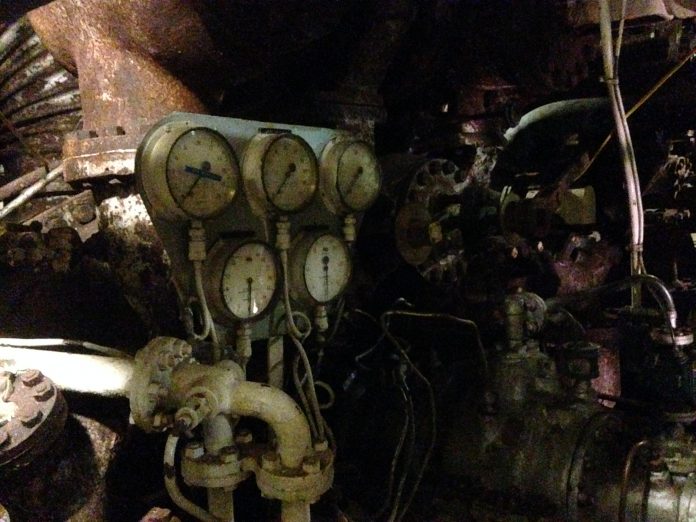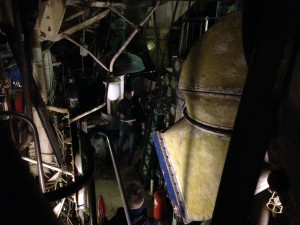No one goes into the engine room of the HMS Cavalier anymore. The majority of the ship, a Royal Navy C-class destroyer that saw action in World War 2 and beyond, is now open for the public to explore at Chatham’s Historic Dockyard in Kent, England. But the tiny manhole and steep steps that lead down into these cramped, rusty remains are usually sealed off for good reason. It’s a maze of machinery, an endless sea of valves and meters that stretches down into a darkness that no man will have set foot in for years.
70 years ago a crew would have had to get cosy with these harsh surroundings, but in 2016 it’s a health and safety headache and the last place you’d want to drop your phone. For exampe:
Nethertheless, that manhole was reopened earlier this week and those steps served once more as a crew descended into the room for a rare opportunity; the chance to film the surroundings in 360 degrees. That crew was the Special Projects division of Wargaming, a developer known for its popular, authentic historic combat titles, World of Tanks and World of Warships. Its work on the HMS Cavalier will serve as footage for the latest series in its range of 360 degree videos, Virtual Inside the Warships which should debut soon. If you’re familar with the company’s Virtual Inside the Tanks series, then you should know what to expect here.
As far as sets go, this is something pretty unique. The task of lighting the room appropriately in every direction has the crew crawling around the scenery. History presenter Dan Snow has been called in to help guide viewers around the ship, and there’s extensive discussion about where he and Barry Knell, author of the book ‘The Fastest Ship in the Fleet: The Story of HMS Cavalier and Her Men’ should stand as they talk. When it comes to shooting, everyone but the presenters has to clear out, either leaving the room entirely or hiding behind a pillar in order to avoid being in the shot.
It’s a new way of filming that’s yet to develop its own set of language and criteria. It looks confusing to organise but, according to Special Projects Lead Matt Daly, this was actually a relatively simple process. “It’s actually a little easier to film a space like that because it’s small,” he tells VRFocus. “So you don’t have to move the camera.” In past videos and even some scenes in this, Wargaming has indeed moved the camera, which Daly explains comes at the cost of some of the framing.
So if you’re not moving the camera and it’s only a small space, why make it 360 at all? That’s something Special Projects asks itself. “When you’re trying to tell good stories, you have to pick technology that’s appropriate to what you’re trying to convey,” says Special Projects Director Tracy Spaight. “So if what you’re doing is intermixing historical footage and talking head interviews and so on, you might want to just stick with a good HD camera and then you’ve got maybe a good 2 or 4K block where you can tell the story that way in a traditional cinematic style.
“But what if your goal were really to explain ‘Well, how does this ship work? What is all this complicated instrumentation and stuff that looks so purposeful? What is this? So, for example, in the engine room, you’re kind of right inside of this engine. It’s all around you. It’s above you, it’s below your feet, there’s pipes everywhere, there’s levers, there’s dials and shafts and huge steam turbine things that fill the entire space. And if you were trying to film it you’d have a lot of cutscenes and a lot of panning around and you’d probably get dizzy trying to do this.”
VR, then, presents an opportunity to do away with that busy work. “But if you’re able to use a 360 VR camera to record this, you could put your spokesperson, your historical person, in the space and then they can simply be gesturing at the things around them,” Spaight adds. ““This dial over here will tell you the pressure, this one is revolutions of the main shaft,” and they can be pointing at these things and you can get the sense that you’re standing there with them in a conversation inside of this big space.”
But 360 degrees presents its own problems, especially when it comes to justifying its use. The answer, then, is to make the scene more active. Along with pointing, the presenters have to move around yet still treating the camera, in Daly’s words, like a third person. The trick is to make a scene almost like a radio conversation, in which people talk in a way that’s aware of that third party.
The director’s job, Daly adds, is also complicated by not being able to watch the scene as it plays out. “You kind of have to fly blind as a director and as anyone really, and leave them to it,” he says. “There’s a lot of different ways we’ve experimented with to keep the director in the room by erasing him. He has to stand in front of a solid coloured wall, right? And then we can erase the director. But we prefer not to have to do that if it’s not absolutely necessary.”
What you might think would be necessary was some mention of Wargaming’s own products in these videos. 360 cotent has been used by a lot of brands as a means of promotion, and this strikes as a perfect opportunity to point history buffs towards these games. But that’s not the goal here. As Daly explains, these videos are more of an attempt to pay respect to the heritage that these games build off of, and grow a relationship with the community that cares so deeply about it.
“It’s hard to see it as a direct promotion because it’s not like we’re on the ship saying “And, just like in World of Warships, this ship has this kind of armament or this kind of strategic utility.” So it would be hard to even make it that way,” he states. “But there’s different ways of positioning one’s self as a brand that isn’t—we’re in an age of a lot of scepticism from like savvy media audiences, particularly younger people that are tired of being marketed directly to.”
What these younger audiences do want, Wargaming thinks, is something realer. “It’s like they want experiences and authenticity, and I feel like the VR video stuff and the way that we’re doing it is authentic,” Daly continues. “And we work with heritage groups like this that are comprised of veterans and people who were raised in military families. Obviously everybody that works at Chatham History Dockyard trust, these are their babies. I mean the historical grounds themselves, you can feel the passion for the historical preservation. We’re nothing if not authentic, I would think.”
With that authenticity, Spaight hopes a new audience will be attracted to learning about this heritage. He talks of how this experience can make these environments accessible to people on the other side of the world or with disabilities. He even ponders a future in which people could use VR to walk around an accurate version of ancient Rome, and expresses interest in Wargaming playing a big part in that story.
There needs to be improvements before that can really happen, though. 360 video faces criticism in the VR community, especially when filmed in 2D. It’s arguably not the full VR experience, maintaining a sense of immersion but perhaps never quite fooling viewers into believing they’ve stepped into the world on display. In Daly’s mind, the steps towards improving this will be ‘incremental’, as features like parallax, which allows for a certain degree of positional tracking within VR, and the removal of stitching in which the seams between videos put together can be seen, become commonplace.
For the nearer future, though, Wargaming looks forward to a time that its content can be shared on improved platforms that are designed with VR in mind. “We believe this is going to be a sustained and continued way that people engage with media,” Daly concludes. “So it’s not like every single VR project that we do is going to be this whizzbang press release thing. The idea is to kind of ‘tech a man to fish’ thing with our in-house production staff.”
Spaight, meanwhile, anticipates continuing this series. “It’s just infinitely open ended,” he says. “Right now this will be the first project we do in the Virtually Inside the Warships project, so I hope we’ll be able to film inside lots of different types of World War 2 vehicles, maybe aircraft carriers, battleships and other things. It’d be fun to use this technology to explain what it was like to serve on one of those ships and what the different critical parts of the ship, how they functioned. Engines rooms, operation rooms, firing control, radio calculation rooms, the bridge. There’s like so much technology with the hardware compartments and the human software dimension that makes this whole thing work together.”
Once engine room filming wrapped, the Special Projects crew packed up and climbed back up those steps and through the manhole for it to be closed once more. Once the first episode of Virtual Inside the Warships releases, however, you could argue that it will never be shut off again.
-END-
The post On Set with Wargaming’s Virtually Inside the Warships 360 Filming appeared first on VRFocus.

















